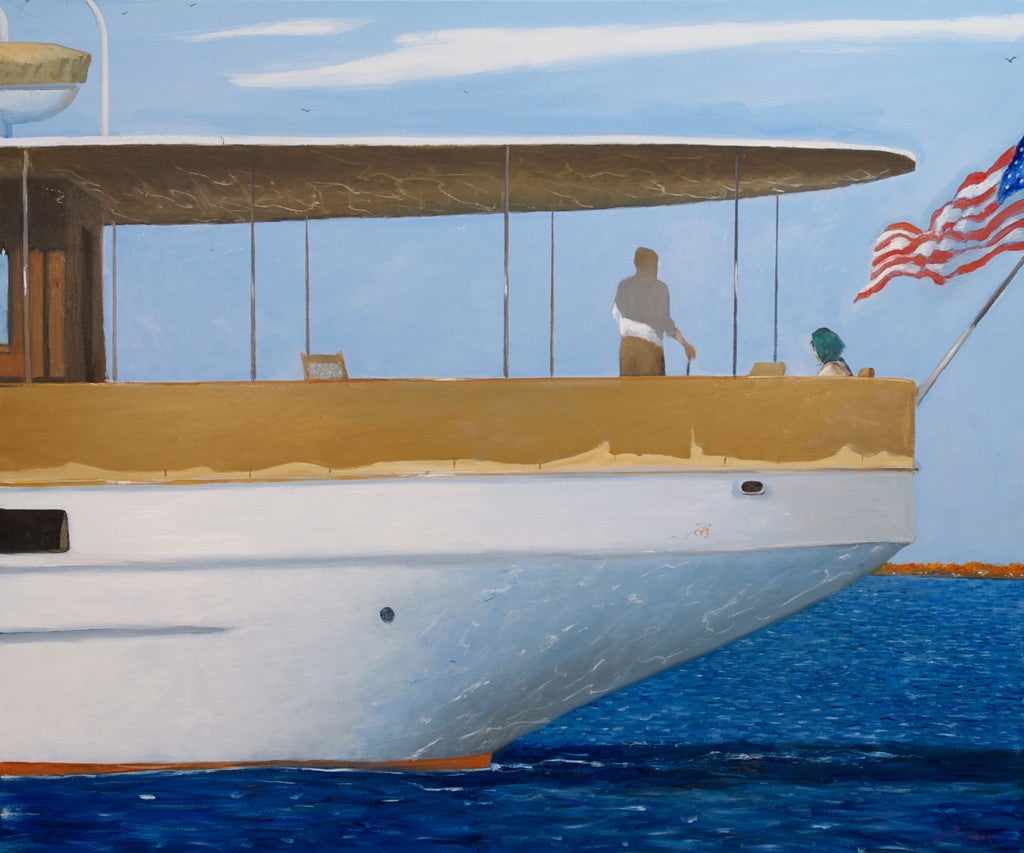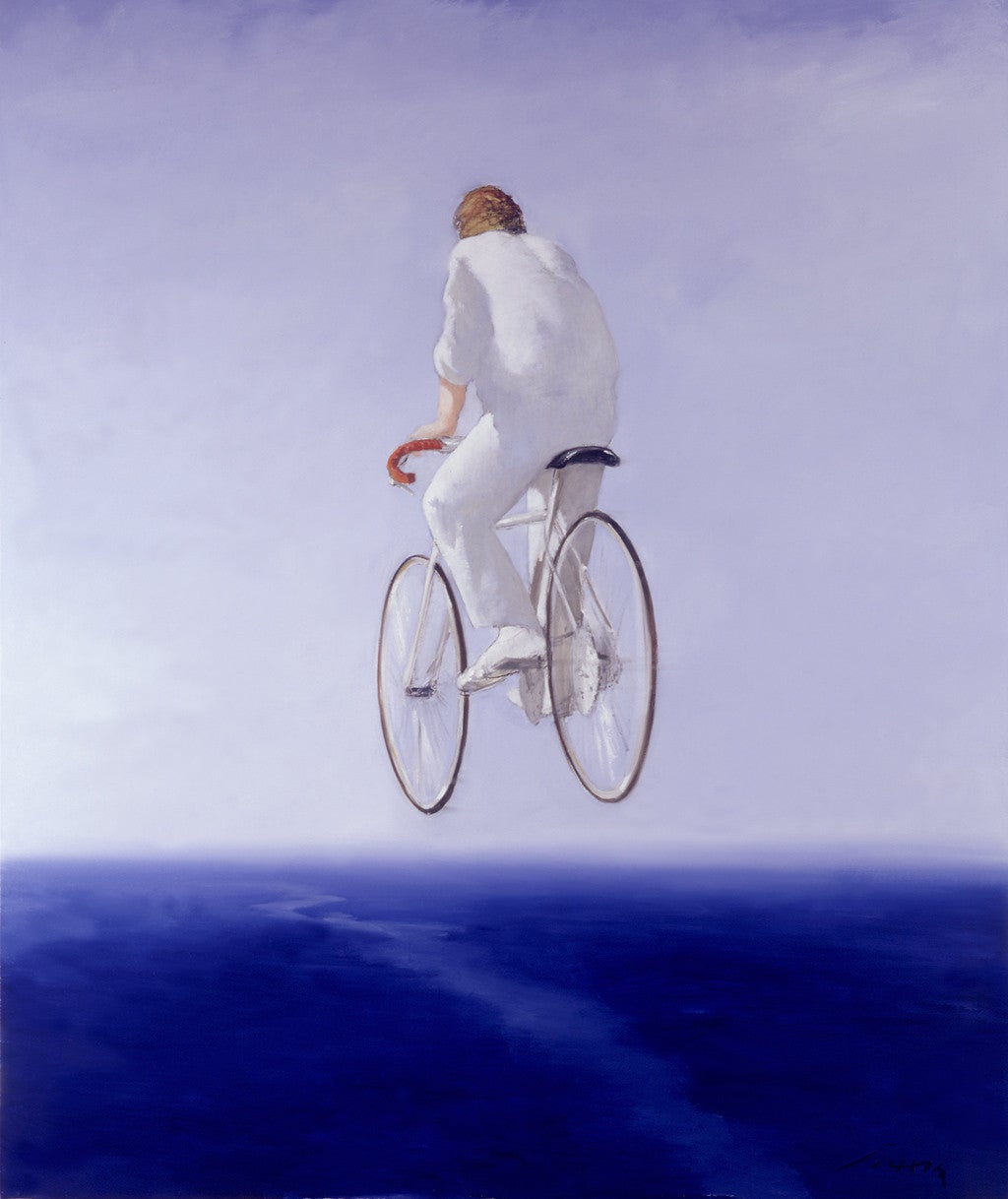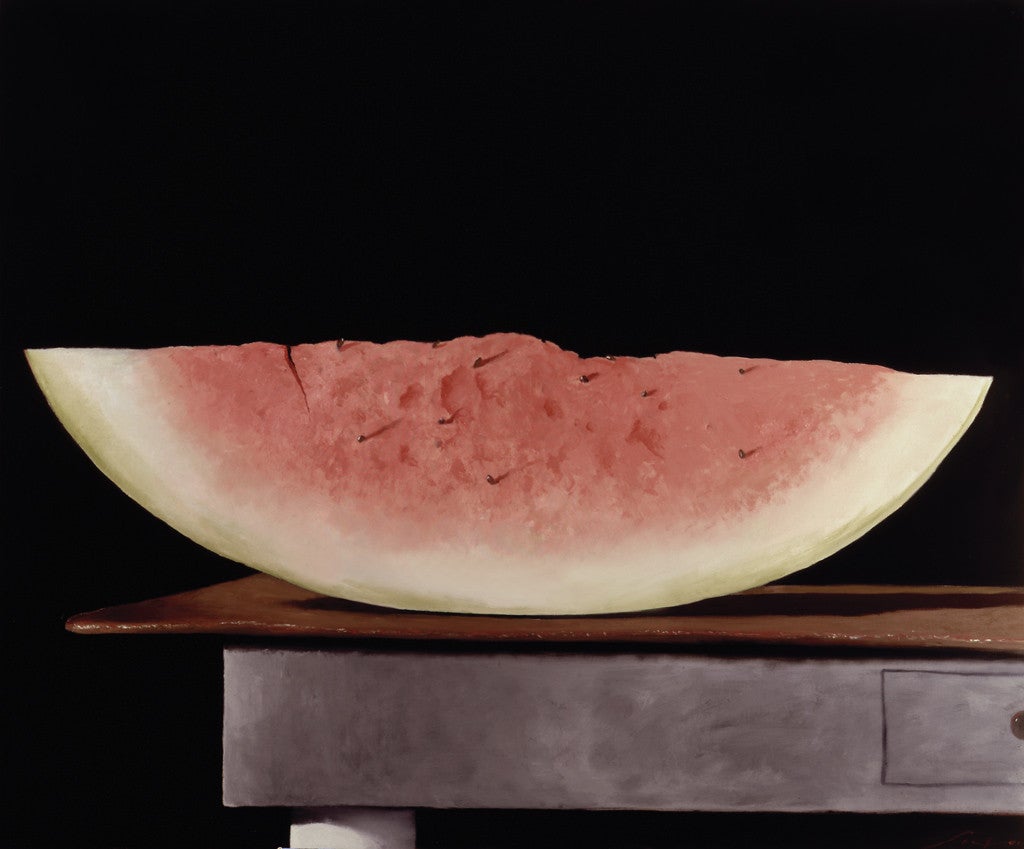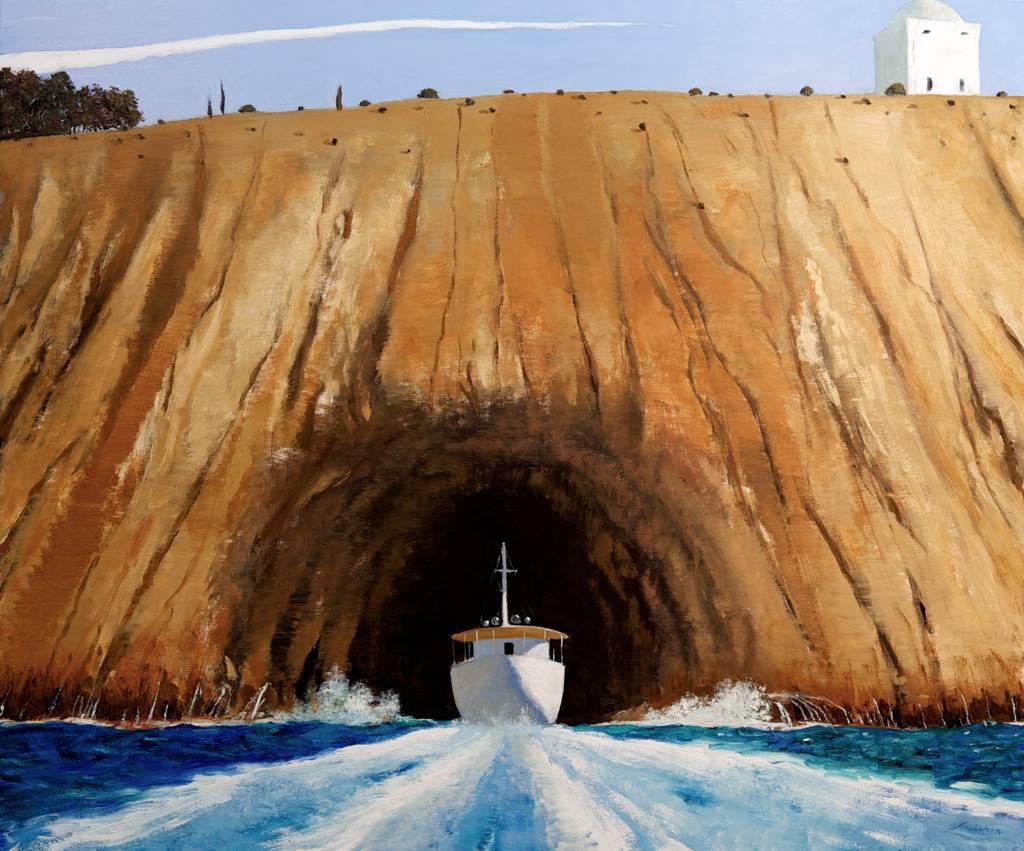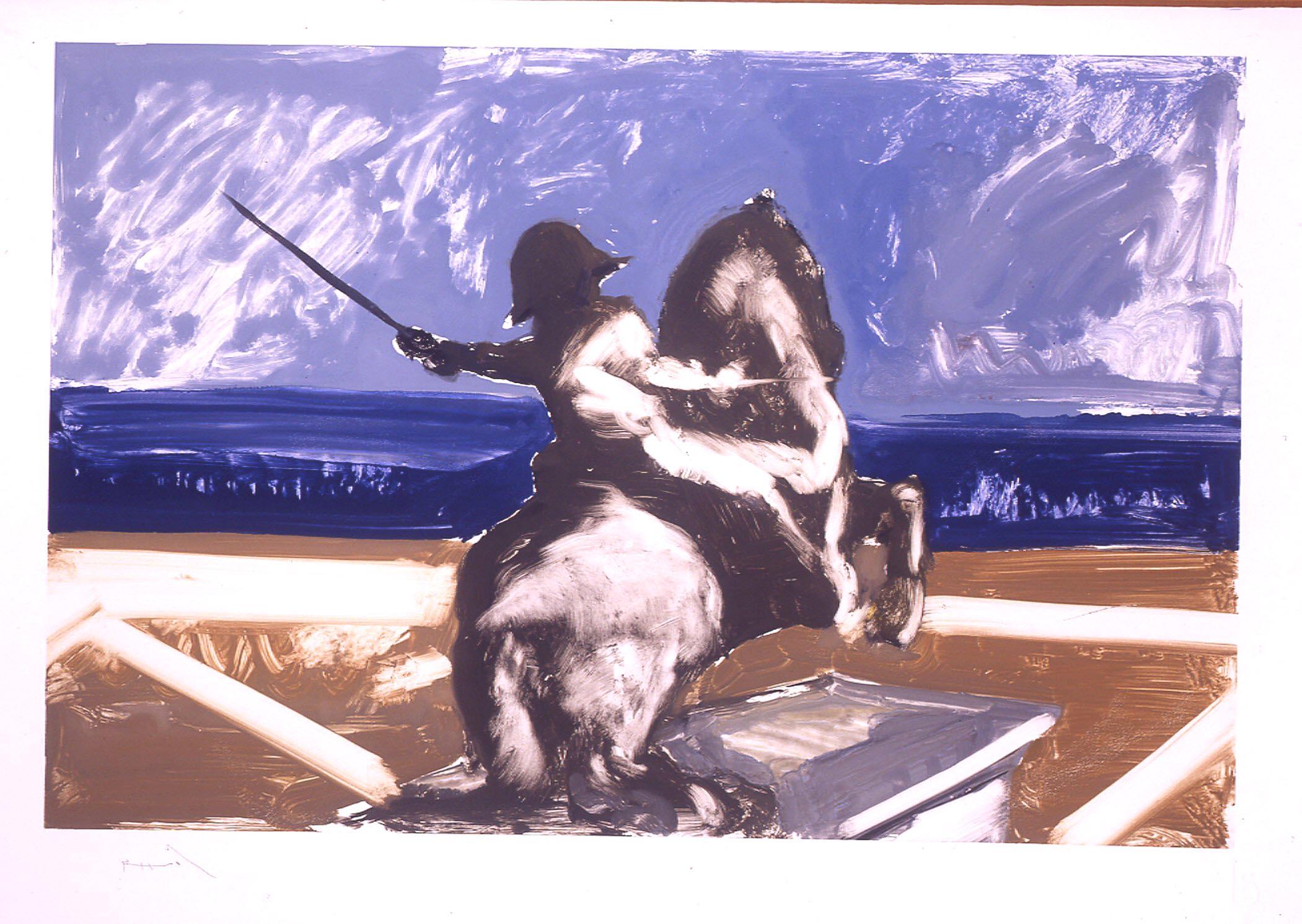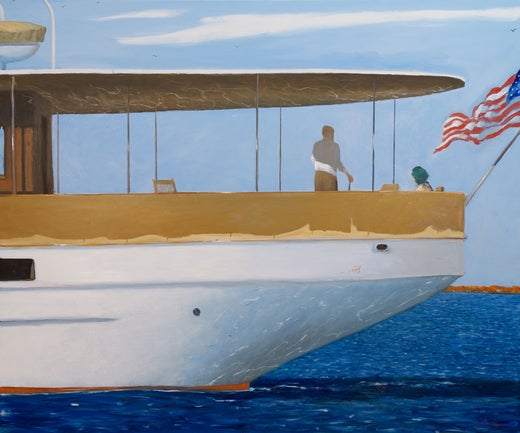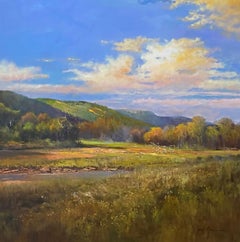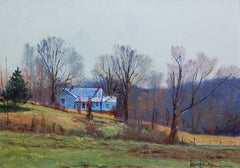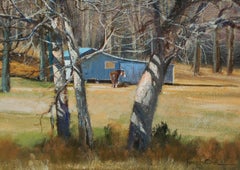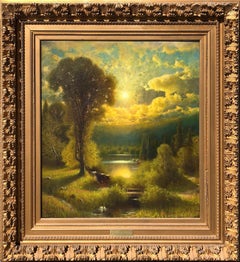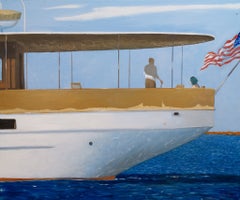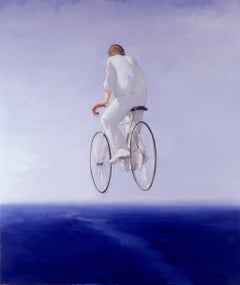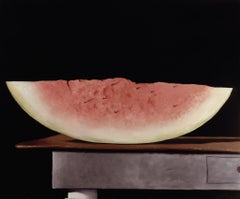Video Loading
Want more images or videos?
Request additional images or videos from the seller
1 of 14
Julio LarrazMad River1996
1996
Price Upon Request
Price Upon Request
Price Upon Request
Price Upon Request
Price Upon Request
Price Upon Request
Price Upon Request
Price Upon Request
Price Upon Request
Price Upon Request
About the Item
Mad River, 1996
Julio Larraz (Cuban, 1944)
Signed and Dated Lower Right
41 x 49 inches
43 x 51 inches with frame
Provenance: Atrium Gallery, 1999
Accomplished painter, sculptor, and draftsman Julio Larraz through his artwork has transcended time and place for more than 50 years to become one of the most influential figures in Latin American and American art. Born in Havana, Cuba in 1944, Larraz is both a Cuban artist and an American artist. His foundation and love for art began to form during his youth and blossomed into an abundant career.
Julio Larraz’s father was a political activist and student who was imprisoned by the Machado regime for three years at the Isle of Pines. When he was released, he would go on to become the owner and editor of a newspaper in Havana, “La Discusion”. Larraz’s mother was a law student who later became the director of the family’s newspaper. In 1959, when Fidel Castro’s regime took control of Cuba, free press was extinguished immediately. With this new change the family realized that they would have to seek asylum in the United States; Julio Larraz was 16 years old.
The experience of being forced into exile and leaving his childhood home in Cuba had a profound effect on Larraz’s life and art. Before his physical exile, Larraz experienced some internal exile as well. As a child, Larraz spent most of his classroom hours perfecting his talents as an artist rather than attending to his schoolwork. He used school as a life drawing class in which he practiced his technique by creating caricatures and cartoons of teachers. Eternally energetic and full of imaginative impulsivity, he was expelled from several schools eventually landing in a military academy run by ex-officers of Fulgencio Batista. The combination of this ex-politically affiliated academy, followed by his eventual exile from Cuba, led to the development and motivation of Larraz’s caricatures. When asked of this introduction he said they “came naturally. [They were] natural, critical observations.” What he describes as more of a feeling than an observation, his caricatures grew in popularity due to their sense of humor, ability to portray each individual personality, and the skilled quality of his work.
Soon after arriving in the United States, he began to draw political caricatures that were published by the New York Times, The Washington Post, Vogue, Rolling Stone, Time, Ramparts, Newsweek, and The Chicago Tribune. The politics which forced him out of the country he loved would in turn carve and model the political undertones of his work. Aside from his well-placed caricatures, attributes such as the sea, imagery of people, faces, and locations have all weaved themselves into his work. He honed and sharpened his technique and the subjects of his work were influenced by the animosity he felt through the challenges and exploits he faced as a growing member of society. Through this journey, Larraz emerged as one of the world’s great painters.
Larraz was recognized professionally as a painter in 1971 with his first solo exhibition at the Pyramid Gallery in Washington, D.C. His work has since shown in galleries throughout the United States, Europe and South America. Larraz’s work has also been represented in numerous group exhibitions and can be found in many public and private collections. He has been the recipient of several awards from the Center for the Arts and Education, New York, NY; FACE, Miami, FL; the American Academy of Arts and Letters and the National Institute of Arts and Letters, New York, NY; and the Instituto de Educación Internacional, New York, NY. His omnivorous dedication to his craft has resulted in an enormous body of work spanning six decades, created in different mediums, and most importantly, contributing to the integration of Latin-American art culture.
In the 1980s, Larraz began experimenting with sculpture, a medium he took to almost immediately. Although he is not always remembered for his migration into the form of sculpture, he has created well known pieces which have graced public spaces, art galleries, and art fairs for years.
Since leaving Cuba, Larraz has lived and worked primarily in the United States, yet the time he has spent traveling has proven to be some of his most prolific. While living in Italy in the late 90s to early 2000s, he created countless watercolors that have added immense volumes to his collection. Larraz spent time living in New Mexico and Paris as well. These cities, landscapes and cultures also influenced and deepened his work, adding to the images he draws upon from within his deep imagination.
The development of Larraz’s work is based on many studies which he then builds into larger works. He borrows the appearance and expressions of people he encounters in his daily life and his travels and these faces often come to life in his work as characters from other worlds, other places, and other times. Larraz refers to this collection of ideas in his imagination as “The Kingdom We Carry Inside”. He speaks of his visions as dreams and describes being forced to do fast sketches in an attempt to capture them before they disappear. “They are like dreams, it’s like when you try to tell someone about a dream you had, and it becomes smoke before you finish the sentence”.
Larraz’s work combines the refinement of a skilled draftsman, and the narratives of a born storyteller, with the surreal distortion of a magician.
In 2004 Julio Larraz returned to Miami where he lives and works today.
- Creator:Julio Larraz (1944, American)
- Creation Year:1996
- Dimensions:Height: 41 in (104.14 cm)Width: 49 in (124.46 cm)
- Medium:
- Movement & Style:
- Period:
- Condition:
- Gallery Location:Missouri, MO
- Reference Number:1stDibs: LU747313466962
Julio Larraz
Julio Larraz was born in Havana, Cuba, March 12, 1944. The son of a newspaper editor, he began drawing at an early age. In 1961 his whole family moved to Miami, Florida. In 1962 they moved again to Washington DC, and in 1964 to New York. There he started drawing political cartoons which were published by the New York Times, Washington Post, Chicago Tribune and Vogue, among others. In 1967 Larraz began working full-time as a professional painter. He credits several New York artists, such as Burt Silverman, for teaching him different painting techniques. In 1971 his first individual show was staged at the Pyramid Gallery in Washington DC. In 1972 he carries out an exhibition at the New School for Social Research in New York and in 1973 another one with the FAR Gallery, also in New York. In 1976 he is awarded by the American Academy of Arts and Letters and the National Institute of Arts and Letters. The same year he is also granted a Cintas scholarship by the International Institute of Education.
A year later Larraz moves to San Patricio, New Mexico, fascinated by the light and atmosphere of the Valle Hondo arid hills. There he meets Ron Hall, who was his gallerist for several years in Dallas, Texas. Ron Hall would become one of his closest friends. In 1983 he travels to Paris, where he stays for two years. The new environment inspires an innovation in his paintings. While in Paris, Larraz also travels to Morocco. In 1984, he moves back to the United States. In 1983 he meets Nohra Haime, whose New York gallery represents him until 1994. In 1998 he began working with the Marlborough Gallery of New York, his exclusive representative for the last fifteen years. Larraz moves to Florence, Italy, in 2000, staying there until 2004. Once again, the place offers him a renewed source of inspiration. In 2004, Larraz begins an association with the Galleria D’Arte Contini in Italy, which was bound to be a deep professional and friendly relationship that remains until the present day. Larraz is a frequent visitor of Italy and in 2006 he produced several monumental sculptures which were exhibited in Pietrasanta. Julio Larraz is renowned for the accuracy and painstakingness of his technique, his imagination and subtlety of touch. Today, his work appears more consolidated than ever. It has become more concise and suggestive, both in the brushstrokes revealing the dexterity of a maestro of painting and in the metaphoric flight of his subjects.
About the Seller
5.0
Vetted Professional Seller
Every seller passes strict standards for authenticity and reliability
Established in 1970
1stDibs seller since 2017
155 sales on 1stDibs
Typical response time: Several days
- ShippingRetrieving quote...Shipping from: Missouri, MO
- Return Policy
Authenticity Guarantee
In the unlikely event there’s an issue with an item’s authenticity, contact us within 1 year for a full refund. DetailsMoney-Back Guarantee
If your item is not as described, is damaged in transit, or does not arrive, contact us within 7 days for a full refund. Details24-Hour Cancellation
You have a 24-hour grace period in which to reconsider your purchase, with no questions asked.Vetted Professional Sellers
Our world-class sellers must adhere to strict standards for service and quality, maintaining the integrity of our listings.Price-Match Guarantee
If you find that a seller listed the same item for a lower price elsewhere, we’ll match it.Trusted Global Delivery
Our best-in-class carrier network provides specialized shipping options worldwide, including custom delivery.More From This Seller
View AllRiver Access
By Joseph Orr
Located in Missouri, MO
Joseph Orr (Japanese, American, b. 1949)
River Access
Signed Lower Right
30 x 30 inches
39.5 x 39.5 inches with frame
BORN in Tokyo, Japan, Oct 31,1949, Joseph lived his first years in an orphanage sponsored by American Armed Forces. He was adopted April,1954 and came to the US at age 5 where he became an American citizen. As the Orr’s traveled for the US military Joseph enjoyed a childhood rich in experiences from Germany and back to California where he attended High School and started College.
Following his parents to Missouri In 1971 he took a job with Hallmark Cards as machine operator in the cardboard fold dept. It sparked an interest in art, so after a few months he sought out some of the Hallmark artists at their work for private lessons. He learned basic drawing and watercolor from Anthony Allison and, “Probably before I was ready”, he admits, Joseph was entering local art shows and even winning prizes. At that time Joseph also enrolled for art instruction under John Coleman at Longview Community College. He spent one semester there.
By the end of 1972 Joseph had quit his day job to become a full time painter, joining an art show tour group called Word Of Art, which was a new concept: culture meets promotion. Booking weekly art exhibits in the new indoor shopping malls across America, The idea transformed part of the art world by bringing art to the masses.
For Joe and many other artists in the early 1970’s, it created the chance to paint full time and sell their work to an otherwise unobtainable audience. During this time of continuous self study and painting Joseph transitioned from watercolor to the newer acrylic painting medium.
Believing that acrylic, as a fine art painting medium, can be as viable as oil, Orr has always promoted it as the modern medium that it is.
In 1990 Joseph, along with his wife, Rita and two other artists, founded the National Oil & Acrylic Painter’s Society. The Orr’s brainchild, they were aided in founding NOAPS organization by local art patrons, Wm & Martha Mitchell and fellow artists Pete Peterson and Dennis T. Yates.
While traveling with the World of Art Tour Joseph had met Rita Mathews, an aspiring artist, in Columbia, MO. They were married in June 1974 and stayed in Missouri, traveling and exhibiting their art together. Orr had a brief encounter with printmaking in 1977. He took private instruction in stone lithography and copper plate etching from Frank Stack, professor of art at the Univ of MO, Columbia, but painting remained his principal devotion.
By 1999 Joseph had become proficient enough to have obtained Gallery representation with several Fine Art Galleries across the US.
Joseph Orr currently resides in Osage Beach, Missouri, but travels to paint and visit his gallery representatives and Exhibit Openings.
PHILOSOPHY:
For me the idea is that painting should follow some form of illustration and truth telling. Basically, the premise of my painting philosophy, is to build layers of narrative into my paintings. A place or landscape scene is never defined satisfactorily without it’s relationship to color and composition. It is important to balance fact with imagination.
“ART REFLECTS THE SOUL OF SOCIETY. A JUDGMENT CAN BE MADE FOR THE ATTITUDE OR CONDITION OF SOCIETY BY INSPECTING THE POPULAR ‘IDEAS’ OF ART OR, IN SOME INSTANCES, THE LACK OF ART.” (JOSEPH C. ORR)
NOTED SOLO EXHIBITS :
*BIRGER SANDZEN MEMORIAL, LINDSBORG, KS;
*HARWELL ART MUSEUM, POPLAR BLUFF, MO;
*ASHBY-HODGE GALLERY OF AMERICAN FINE ART, FAYETTE, MO;
*NORFOLK ART CENTER, NORFOLK, NE;
*KODNER GALLERIES...
Category
20th Century Contemporary Landscape Paintings
Materials
Canvas, Acrylic
$10,000
Banker's Dream
By Joseph Orr
Located in Missouri, MO
Joseph Orr (b. 1949, Missouri)
"Banker's Dream"
Acrylic on Canvas
Canvas: 9 x 12
Framed Size: approx 12 x 16
Joseph Orr, from Missouri, has been painting p...
Category
2010s American Realist Landscape Paintings
Materials
Canvas, Acrylic
The Home Place
By Joseph Orr
Located in Missouri, MO
Joseph Orr (b. 1949)
"The Home Place"
Acrylic on Canvas
Canvas Size: 9 x 12
Framed Size: approx 12 x 16
Joseph Orr, from Missouri, has been painting profes...
Category
2010s American Realist Landscape Paintings
Materials
Canvas, Acrylic
Sunset
By James Fairman
Located in Missouri, MO
James Fairman
"Sunset" c. 1880
Oil on Canvas
Signed Lower Left
Site: 32.5 x 29.5 inches
Framed: 46 x 42 inches
James Fairman worked as a landscape painter, critic, lecturer, musicia...
Category
1880s American Realist Landscape Paintings
Materials
Canvas, Oil
Price Upon Request
Herring Gulls
By Jamie Wyeth
Located in Missouri, MO
Jamie Wyeth
"Herring Gulls" 1978
Color Lithograph
Signed Lower Right
Numbered Lower Left 149/300
Born in 1946, James Browning Wyeth came of age when the meaning of patriotism was clouded by the traumas of the Vietnam War and the scandals of Watergate. Working in an era of turmoil and questioning of governmental authority, he did art that encompassed both marching off to war and marching in protest.
One of James's early masterworks, Draft Age (1965) depicts a childhood friend as a defiant Vietnam-era teenager resplendent in dark sunglasses and black leather jacket in a suitably insouciant pose.
Two years later Wyeth painstakingly composed a haunting, posthumous Portrait of President John F. Kennedy (1967) that seems to catch the martyred Chief Executive in a moment of agonized indecision. As Wyeth Center curator Lauren Raye Smith points out, Wyeth "did not deify the slain president, [but] on the contrary made him seem almost too human."
Based on hours of study and sketching of JFK's brothers Robert and Edward -
documented by insightful studies in the exhibition - the final, pensive portrait seemed too realistic to family members and friends. "His brother Robert," writes Smith in the exhibition catalogue, "reportedly felt uneasy about this depiction, and said it reminded him of the President during the Bay of Pigs invasion."
In spite of these misgivings, James's JFK likeness has been reproduced frequently and is one of the highlights of this show. The poignancy, appeal and perceptiveness of this portrait, painted when the youngest Wyeth was 21 years old, makes one wish he would do more portraits of important public figures.
James himself feels he is at his best painting people he knows well, as exemplified by his vibrant Portrait of Jean Kennedy Smith (1972), which captures the vitality of the slain President's handsome sister.
He did paint a portrait of Jimmy Carter for the January 1977 man-of-the-year cover of Time magazine, showing the casually dressed President-elect as a straightforward character posed under a flag-draped water tower next to the family peanut plant in Plains, Ga. James recalls that Carter had one Secret Service agent guarding him as he posed outdoors, a far cry from the protection our Chief Executives require today.
As a participating artist in the "Eyewitness to Space" program organized by the National Aeronautics and Space Administration in collaboration with the National Gallery of Art in the late 1960s, Wyeth deftly recorded in a series of watercolors his eyewitness observations of dramatic spacecraft launchings and more mundane scenes associated with the space program.
Commissioned by Harper's Magazine to cover the 1974 congressional hearings and trials of Watergate figures, James Wyeth executed a series of perceptive and now evocative sketches that recall those dark chapters in our history. Memorable images include a scowling John Ehrlichman, a hollow-eyed Bob Haldeman, an owlish Charles Colson, a focused Congressman Peter Rodino, a grim visaged Father/ Congressman Robert Drinan, and vignettes of the press and various courtroom activities. An 11-by-14-inch pencil sketch of the unflappable Judge John Sirica is especially well done. These "images are powerful as historical records," observes Smith, "and as lyrically journalistic impressions of events that changed the nation forever."
Wyeth's sketch of early-morning crowds lined up outside the Supreme Court
building hoping to hear the Watergate case, with the ubiquitous TV cameramen looking on, is reminiscent of recent scenes as the high court grappled with the Bush-Gore contest.
The Wyeth family penchant for whimsy and enigmatic images is evident in Islanders (1990), showing two of James's friends, wearing goofy hats, sitting on the porch of a small Monhegan Island (Me.) cottage draped with a large American flag. Mixing the serious symbolism of Old Glory with the irreverent appearance of the two men, James has created a puzzling but interesting composition.
Painting White House...
Category
1970s American Modern Animal Prints
Materials
Lithograph, Paper
Price Upon Request
Work and Play
By Gordon Grant
Located in Missouri, MO
Gordan Hope Grant (1875-1962)
"Work and Play"
Lithograph
Signed in Pencil Lower Right
Image Size: 9 x 11.5 inches
Framed Size: approx 18 x 20.5 inches
Born in San Francisco, Gordon Grant is known for his etchings and paintings of marine subjects. He also painted portraits, streets, harbors, beaches and marines, and was an illustrator, whose work included pulp fiction* for Popular Detective magazine in the 1930s. Skilled with watercolor, Grant was honored many times by the American Watercolor Society*. Memberships included the Society of Illustrators*, Salmagundi Club*, Allied Artists of America*, New York Society of Painters, and American Federation of Artists*.
At age 13, he was sent to Scotland for schooling, and the four-month sail around Cape Horn remained a permanent influence on his career. He studied art in Heatherly and at the Lambeth School of Art* in London, and then in 1895, he became a staff artist for the San Francisco Examiner. The next year, he took the same type of job for the New York World and covered the Boer War for Harper's Weekly. He also worked for Puck magazine...
Category
Mid-20th Century American Realist Figurative Prints
Materials
Lithograph
Price Upon Request
You May Also Like
Sunday on the Narragansett
By Julio Larraz
Located in New York, NY
ABOUT THIS PIECE: Julio Larraz is an expert draftsman, adroitly sketching his subjects and enlivening them with vibrant color. Larraz is recognized for his precise and detailed techn...
Category
Early 2000s Prints and Multiples
Materials
Photographic Paper
Dream, Children Please
By Julio Larraz
Located in New York, NY
ABOUT THIS PIECE: Julio Larraz is an expert draftsman, adroitly sketching his subjects and enlivening them with vibrant color. Larraz is recognized for his precise and detailed techn...
Category
Early 2000s Abstract Prints
Materials
Photographic Paper
Mezza Luna
By Julio Larraz
Located in New York, NY
ABOUT THIS PIECE: Julio Larraz is an expert draftsman, adroitly sketching his subjects and enlivening them with vibrant color. Larraz is recognized for his precise and detailed techn...
Category
Early 2000s Prints and Multiples
Materials
Photographic Paper
The End of Very Long Day
By Julio Larraz
Located in Miami, FL
Julio Larraz
“The End of Very Long Day” 2010
Oil on Canvas
20 x 24 in
Signed by the artist
Certificate of Authenticity by Julio Larraz
Category
21st Century and Contemporary Contemporary Landscape Paintings
Materials
Canvas, Oil
Coming Home
By Julio Larraz
Located in New York, NY
ABOUT THIS PIECE: Julio Larraz is an expert draftsman, adroitly sketching his subjects and enlivening them with vibrant color. Larraz is recognized for his precise and detailed techn...
Category
Early 2000s Landscape Prints
Materials
Photographic Paper
EL PADRE DE LA PATRIA NUEVA
By Julio Larraz
Located in New York, NY
color monotpy of soldier on a horse with raised sword
Category
1990s Contemporary Prints and Multiples
Materials
Monotype
$11,200 Sale Price
32% Off
More Ways To Browse
Fidel Castro
La Sirene
Memento Mori Art
Noir Painting
Peter Max Oil On Canvas
Pin Up Art
R Styles Painting
Used Rickshaws
Woman Swimming
17th Century Mythology Oil Painting
Ashcan Oil Painting
Cowgirl Art
Israeli Artists Painting
Raphael Oil Paintings
Steve Huston
Wpa Paintings Social Realism
Anne Marie Of France
Ballerina Antique
